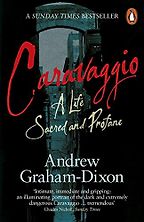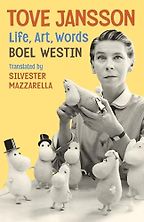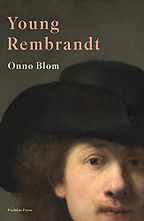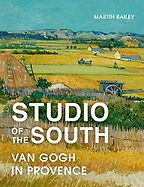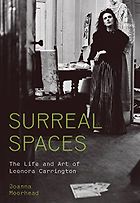Before we get to the books you’ve chosen, what do you think makes a good biography of an artist?
Well, I chose these books because they’re so very, very different. If you take the biographies of the two female artists, Leonora Carrington and Tove Jansson, they are written by people who know every single detail of their lives. They couldn’t be more detailed and, of course, that’s the easy way to write a biography of an artist, isn’t it? You pour it all in.
But then, just as good, I think, is the Caravaggio biography where we have really very few facts—and yet Andrew Graham Dixon has written practically a 400-page book. Then there’s the one on the young Rembrandt, where the biographer admits that he knows nothing about the first 25 years of Rembrandt’s life. And, yet, it gives you just as strong a feeling of the artist’s life and its relation to the work.
I think it’s just fascinating that biographers can do it both ways: the macro approach and the micro approach.
In the biography-of-artist genre there is this sense—perhaps going back to Benvenuto Cellini’s memoir in the 16th century—that artists’ lives are different from those of ordinary people. Is that something that you believe in, or that comes out in these biographies?
I don’t think it’s an absolute given. It’s not a rule. I mean, there are people like Caravaggio, who was obviously exceptional and like a thunderstorm descending on the earth. But then if you think of people like T.S. Eliot, there are the people in suits who are just very well camouflaged.
Let’s turn to that biography of Caravaggio (1571-1610), one of the great Italian painters, by the British art critic Andrew Graham Dixon. It’s called Caravaggio: A Life Sacred and Profane. Tell me more.
It’s amazing because, as I said, we really know very, very little about Caravaggio except that he had a quarrel about artichokes and killed somebody, possibly over a bet on a tennis match, or possibly over a woman. Out of this, Graham Dixon, who is a superb art historian, has made an absolute blood-and-guts, pacy book.
Caravaggio was an arrogant, rebellious murderer. Graham Dixon manages to pull the tempestuous life out of the tempestuous times. This is the Rome of the popes and Machiavellian power games and the struggles of the Counter-Reformation. Rome is being rebuilt as a show-off Baroque city. You’re getting out of the rather straitlaced, scholarly Renaissance into the hurly-burly of the Baroque and it’s very sensual.
That life, the development of Rome and the political developments of the time, match what we know of Caravaggio’s technique, which was very fast and spontaneous, like his temper. He painted tremendously fast, and then, when he’d finished it, he would go dragging around town for a few weeks.
This book, I think, is brilliant. It reads like a thriller. It’s incredibly colorful. It’s a very masculine book about a very masculine subject.
You’ve written a number of wonderful biographies yourself. What prompted you to turn your attention to the French artist Paul Gauguin (1848-1903) and write a biography of him?
It’s always the same with my biographies: I want to find out more about people whose work I admire. With Edvard Munch, August Strindberg, Friedrich Nietzsche and Paul Gauguin nobody had written a book that I wanted to read.
It was really at the start of lockdown. There was a marvelous exhibition at the National Gallery of Gauguin’s portraits. They always do wonderful lecture series at the National Gallery and I realized how long ago it was that he had been written about.
When was the last biography of Gauguin published?
It was 30 years ago, by someone called David Sweetman, and so a heck of a lot has come to light since then. Two things happened in 2020-1. Firstly, the catalogue raisonné of Gauguin’s work was at last completed. So you really had all the information on his work.
Secondly, in the last three years of his life, Gauguin wrote a book called Avant et après. It’s a 200-page handwritten and indeed hand-illustrated testament. It’s what he thought about life and art and God and everything. It disappeared soon after his death and was published in a messed-up version. Then, in 2020, the original was offered to the British government in lieu of death duties. This manuscript, which had been lost for a century, reappeared.
So with that—200 pages of Gauguin’s thoughts in his own handwriting—and the catalogue raisonné it seemed that one had a pretty solid base for a new biography.
What was the most surprising thing that you found out about Gauguin as you wrote about him?
There were many surprising things.
I had no idea he spent his first seven years in Peru, running wild in a palace with jaguars and volcanos—it reads like a magical realist South American novel. Then his mother took him back to France, aged seven. He couldn’t speak French, and he was put in a very strict Catholic seminary. When they bullied him, he put up his fists and said, ‘I’m a wild thing from Peru.’ That gave me the title of the book, but it also gave him his attitude from then on. He’s an outsider, and he’s searching for comparable places. When he lost all his money, the French government paid his passage out to Tahiti to be the official artist.
He has this reputation as a French colonialist, going out and taking advantage of the Polynesians, but when he gets there, he’s disgusted by the French colonial regime, which is very oppressive and invasive, bullying the Polynesians. Then, gradually, he becomes their spokesman against the French colonial rulers. He writes to Paris about how the islanders are taxed unjustly. He starts to represent them in the French colonial courts.
I was fascinated to discover all that—the papers, the letters he wrote to the authorities in Paris and so on. It’s an aspect of Gauguin in Tahiti which hadn’t been explored and that people don’t really talk about.
You also describe in your book the finding of his bones, and how the DNA revealed he didn’t have syphilis.
That’s right, that’s another legend.
The other thing that was discovered—not by me—was the birth certificate of Teha’amana, his first ‘wife’ in Tahiti. Everyone said she was 13 but her birth certificate shows she was, in fact, 15. It’s still pretty disgusting, but the age of consent in France and the colonies at the time was 13. In the United States, it was between 10 and 12, except the state of Delaware where it was seven. It disgusts me but Gauguin wasn’t doing anything illegal or at all unusual associating with these young girls.
So you wrote about Gauguin because you loved his art. Does that go without saying, when you embark on the biography of an artist?
Yes. You use the word love, but actually it’s a burning interest in the work that won’t leave me alone. Nietzsche puts it so well when he talks about ‘a fishhook in the brain’. The fishhook just tugs and tugs and you want to know more and more, and you desperately want to understand.
Let’s go on to the next book you’ve chosen, which is a biography of Tove Jansson (1914-2001), the creator of the Moomins, by Boel Westin. Tell me why you picked this book.
I spent my early years in Norway and the Moomins were my surrogate family. There was hopeless old Moominpappa in his top hats being all grand, and Moominmamma in her apron who gets all the work done. It’s very feminist and they hit a universal nerve. So I loved Tove Jansson as a child.
Then, when I read this biography, I realized that actually the Moomins started as Jansson’s political signature. When Hitler was annexing parts of Europe, she was drawing rude cartoons of him and signing them with a little Moomin. After the Munich Conference, she drew Hitler like a spoiled baby bawling for more cake while ignoring the slices of Europe he had already annexed. She said that what she liked best was being beastly to Hitler and Stalin. Her Moomin books are about political expression and not just domestic expression.
Is she known for her art beyond her cartoons? I think I’ve seen her self-portraits.
She draws wonderfully and she was always painting. She did murals in public spaces like factories and schools. But it’s not a finished body of work, if you know what I mean.
Let’s turn to your next choice, Young Rembrandt by Onno Blom. This is about the early life of the great 17th-century Dutch painter, Rembrandt van Rijn (1606-1669).
We’re not even certain of Rembrandt’s exact birth date, but he was born around the time Caravaggio died. If you think of Caravaggio’s work, in a way it looks so much more modern than Rembrandt’s, doesn’t it? Because it’s so sensual and so theatrical.
What Onno Blom is really asking in this biography is, ‘How did a miller’s son from a provincial Dutch town become the greatest artist of his time?’ It’s just about Rembrandt’s first years. It’s a description of Leiden, this small provincial town steeped in scriptural Protestantism.
Then, when Rembrandt gets to Amsterdam, he blooms.
Onno Blom says that what was really important—and I think this is very interesting—was the anatomy theater. Leiden had the earliest anatomy theater in the Dutch Republic. There’s obviously Rembrandt’s painting of the anatomy lesson, but there are also crucifixions and the descent from the cross. Apparently, Leiden’s anatomy theatre had a skeleton tableau mort of Adam and Eve. Adam’s skeleton had its hands curled around a spade because Adam is digging and Eve was reaching up to pick the forbidden apple. It’s a wonderfully creepy image isn’t it?
Leiden also had a very famous botanical garden, which may have had an influence on his pictures. And it was famous for its bookshops, which had lots of prints, as well as cabinets of curiosities and stuffed crocodiles etc. Blom conjures a very rich world from which this miller’s son pulled everything together into his paintings.
With Gauguin, you suggest in your biography that his art improved when he stopped leading a satisfied bourgeois life. Is there a sense in which, from your observations, artists have to suffer in order to create their best art?
Everything is created from suffering including, paradoxically, great happiness and great art. That’s what I think.
Let’s move on to your next choice, a biography of the British-born painter Leonora Carrington (1917-2011), probably the least known of the artists on this list.
Leonora Carrington is going to seriously hit the headlines. The biography is by a relative of hers who is a journalist, Joanna Moorhead. She’s a mover and a shaker and I read the other day that the film rights have been sold. It’s a very colorful life that will certainly make a heck of a film! From debutante in Lancashire, to founder of women’s lib in Mexico. This is the most tabloid of the books and its style is rather suited to Leonora’s life and art, actually.
Is she known as a surrealist?
Yes, and will be better known as a surrealist after the movie. What I’m interested in is the difference between Leonora as a surrealist and the male surrealists. It connects to Gauguin and symbolism. People called him a symbolist, though he hated labels. He said, ‘Don’t call me a symbolist. Don’t call me anything. I want to be free as an artist.’
But the male surrealists loved the label. They really delved into Freudian symbolism and do it in that gorgeous, varnished sort of finish. Leonora is much softer in her finish and her symbols are not recognizable. I wanted to find out what was going on in her head. She said: ‘What I don’t want to be is understood. I don’t want these to be interpreted.’ I find that very interesting.
One question you haven’t asked me is about insanity and art. Leonora was shut up in an asylum and given electroconvulsive therapy. Then there’s Van Gogh and his mental illness.
On that note, let’s turn to your last choice: Studio of the South: Van Gogh in Provence by Martin Bailey. I was very struck that in these 15 months in Arles, van Gogh was producing three paintings a week.
I agree. It’s absolutely fascinating. He was driven, driven, driven.
Tell me about this period, and also how Gauguin comes into van Gogh’s story, which you cover in your book, but maybe not everyone knows about.
Van Gogh was driving his brother Theo mad in Paris. So Theo says, ‘I’ll give you some money to go down to the south of France.’ Vincent wants to be like the Pre-Raphaelites, so he buys 12 chairs for his disciples, and invites them down to Arles. Only Gauguin comes. So there are two of them on 12 chairs.
Van Gogh gets so excited about Gauguin coming that he paints his famous sunflower paintings—Fourteen Sunflowers and Fifteen Sunflowers—and hangs them in Gauguin’s bedroom as a huge welcoming bouquet. It’s so very, very touching.
I liked the inclusion of photos in Studio in the South—comparing what van Gogh was painting with what he actually saw.
Martin Bailey is the most amazing van Gogh scholar. This book has everything you might want to know about that period in his life that produced all those paintings that everyone adores: the orchards, the sower etc. It’s a great book.
Interview by Sophie Roell, Editor
September 12, 2024. Updated: September 14, 2024
Five Books aims to keep its book recommendations and interviews up to date. If you are the interviewee and would like to update your choice of books (or even just what you say about them) please email us at [email protected]
Five Books interviews are expensive to produce. If you've enjoyed this interview, please support us by donating a small amount.


